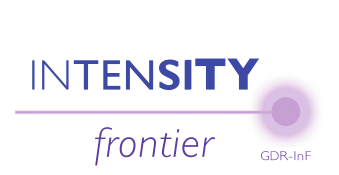GDR-Intensity Frontier lectures: Effective Field Theories Part II
Videoconference
Effective Field Theories Part II
Lectures by Thomas Mannel and Thomas Becher
The GDR-Intensity lectures: from theory to experiment and everything in between.
This series of lectures, organized in the framework of the GDR-InF, is devoted to topics currently of considerable interest in the high-intensity frontier. Two experts will dissect a given subject entirely on the virtual blackboard, starting from the basics. The lectures are aimed at people in the early stages of their research career, in particular PhD students
and postdocs, but more senior researchers are more than welcome to attend.
Lecture notes on HQET can be found here.
Links to videos of the HQET lectures are: lecture 1, lecture 2 and lecture 3
(unfortunately only the second half of lecture 2 is available).
The lecture notes for SCET can be found here for lecture 1, here for lecture 2 and here/here for lecture 3.
Links to videos of the SCET lectures are: lecture 1
Heavy Quark Effective Theory and the Heavy Quark Expansion (Thomas Mannel)
In the first part of this lecture series I introduce the effective theory for a heavy quark by studying QCD in the infinite mass limit. I discuss how to compute perturbative as well as how include non-perturbative corrections. A few applications are considered, also with respect to phenomenological applications.
In the second part I discuss how to treat inclusive weak decays of heavy hadrons. Staring from an operator product expansion the systematic expansion of inclusive observables in inverse powers of the heavy-quark mass as well as a perturbative expansion in alpha_s is obtained. Finally some important phenomenological applications are discussed.
Soft-Collinear Effective Theory (Thomas Becher)
High-energy processes at colliders involve an interesting interplay of soft and collinear emissions. An understanding of the structure of these emissions is at the heart of the factorization theorems on which all computations of collider processes are based. Soft-Collinear Effective Theory (SCET) provides a modern language to analyze factorization and is a convenient tool to perform resummations of enhanced higher-order corrections. These lectures will provide an introduction to this effective field theory, by first discussing the physics of soft and collinear emissions on a diagrammatic level and then implementing their structure into an effective Lagrangian. We then discuss applications and show how the effective field theory can be used to improve predictions for multi-scale problems at colliders.
The zoom link is: https://cern.zoom.us/j/63780158445?pwd=cUNwRExLNDBPTGxLc0NkenVjNEkvdz09

Alessandro Scarabotto
Alexandre Carvunis
Aoife Bharucha
Camille Normand
Emanuelle Pinsard
Gaya Benane
Giampiero Mancinelli
Halime Sazak
Jakob Müller
Jessy Daniel
Joel Ströhmann
Jérôme Charles
Letizia Parato
Marco Ardu
Martín Novoa-Brunet
Matthew Black
Maximilien Chefdeville
Michele Frigerio
Méril Reboud
Olcyr Sumensari
Olivier LEROY
Pascal Vincent
Rhea Moutafis
Sacha Davidson
Shireen Gangal
Sophie Mutzel
Tejhas Kapoor
Timothy Salgues
Véronique Bernard
Yasmine Amhis
Zhuoran Huang
